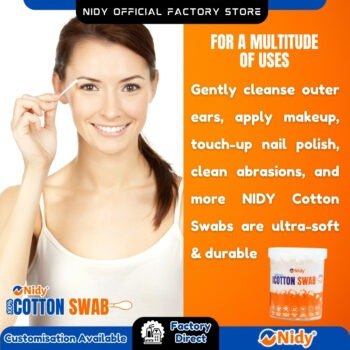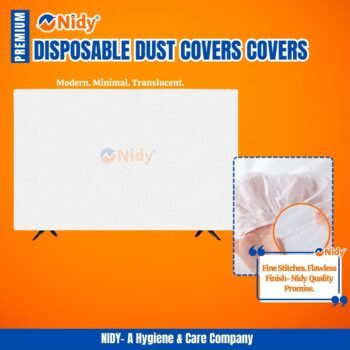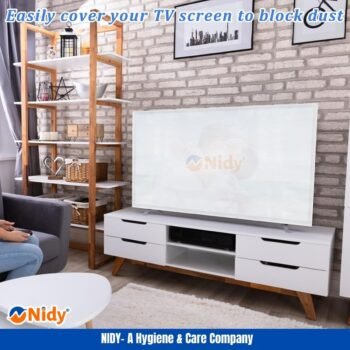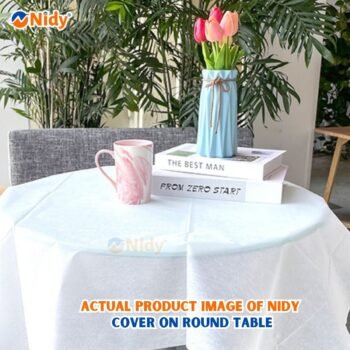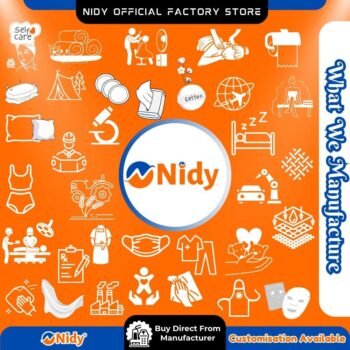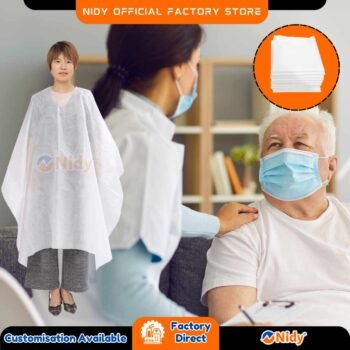
You Save
You Save
You Save
You Save
You Save
You Save
You Save
Shop Nidy Nonwoven Fabrics in Protective Clothing & Apparel: Reliable Safety and Comfort Solutions.
Nidy Nonwoven Fabrics in Protective Clothing & Apparel offer a comprehensive range of safety solutions designed to enhance protection and comfort in various industrial and healthcare settings. Our advanced nonwoven fabrics are crafted with precision to meet stringent safety standards, providing durability and reliability in protective garments such as coveralls, gowns, masks, and gloves. These fabrics are engineered to offer barrier protection against contaminants, fluids, and hazardous particles, ensuring the safety and well-being of wearers. Ideal for healthcare professionals, industrial workers, and those in sensitive environments, Nidy’s protective clothing and apparel prioritize both functionality and comfort. Explore our collection online to discover high-quality, cost-effective solutions that meet your safety requirements without compromising on performance.
Initially, nonwoven fabrics were primarily used in protective clothing and shelters (such as tents). However, over the past few years, the nonwoven industry has experienced significant growth, expanding beyond its traditional applications in geotextiles, diapers, filters, and bags to now include the fashion apparel industry. This evolution is made possible by advancements in nonwoven fabric properties. Unlike traditional fabric manufacturing processes that involve converting fibers into yarns before weaving, nonwoven fabrics are directly formed from fibers. They offer numerous advantages over traditional fabrics, with cost savings being the most apparent benefit.
In the late 1960s, there were initial attempts to market disposable dresses, which did not succeed. Recent research has led to the development of nonwoven fabrics with improved drape, feel, durability, stretch, and recovery. These enhanced characteristics have significantly expanded their applications in the apparel industry, including interlinings, clothing, glove insulation, and components like bra and shoulder padding. As perceptions shift and these fabrics prove their modern capabilities, there is a growing acceptance and adoption of nonwoven fabrics in contemporary fashion concepts.
Non-woven fabric used in protective clothing & apparel, click here to order it.
Why use nonwovens in protective clothing?
Nonwoven fabrics are extensively utilized in the medical field and for protection against liquids, biological agents, and chemical substances across various sectors. They play crucial roles in clean rooms, laboratories, and the electronics industry, safeguarding materials, products, and components from human contamination. In medical applications, nonwovens are integral to surgical gowns, masks, drapes, and wound dressings, providing effective barriers against pathogens and maintaining sterile environments. Their versatility extends to industrial settings where they shield against hazardous chemicals and maintain controlled environments essential for sensitive electronic components. Nonwoven fabrics’ ability to offer reliable protection and maintain cleanliness makes them indispensable across diverse industries.
The different uses are:
- Chemical handling
- Petchem industry
- Automotive industry
- Pharmaceutical industry (Manufacturing and Packaging)
- Laboratories
- Food industry
- Visitors, inspectors across in industry
- Agriculture and horticulture, veterinary inspections, farms, facilities etc.
- Decontamination of contaminated land
- Decommissioning of production plants
- Oil handling, oil tanker cleaning
- Tank cleaning
- Industrial cleaning and maintenance
- Hazardous waste clean-up
- Disease and disaster management
- Emergency response services, spill clean up
- Police
- Medical applications
Nonwoven fabrics are employed extensively as protection against a wide range of substances that could be harmful upon human contact. These include asbestos, dioxins, body fluids, hazardous gases, oils, lubricants, inorganic and organic chemicals, dyes, colors, inks, disinfectants, nutraceuticals such as vitamins, dirt, fine dust, liquid aerosols, splashes, and liquids under pressure. Their disposable nature allows for single-use applications followed by safe incineration, minimizing the need for handling and reducing the spread of contaminants. This makes nonwoven fabrics crucial in maintaining safety and cleanliness in environments where protection against hazardous substances is paramount.
The advantages of using nonwovens in protective clothing:
- Protection against
- dry or wet contact
- air-borne particles
- Flex cracking resistance
- Single-use = 100% certainty
- Excellent barrier properties
- Excellent uniformity
- Breathability
- Abrasion resistance
- Repellence
- Trapezoidal tear strength
- Tensile strength
- Puncture resistance
- Resistance to permeation of liquids
- Resistance to ignition
- Liquid repellence
- Flame retardancy
Nonwovens technologies used in protective clothing:
- Drylaid
- Meltblown
- Spunlaid
- Hydro-entanglement
Few of the nonwoven fabrics developed with various kinds of fibers are mentioned below:
- Cotton-polyester blended nonwoven fabric
- Polyester nonwoven fabric
- Silk nonwoven fabric
- Wool nonwoven fabric
- Polyester durable nonwoven fabric
A 100% polyester nonwoven fabric can be produced through a hydro-entanglement process. Initially, the nonwoven web undergoes an image processing step to impart a final design. The web then passes through three water jet nozzle sections at a speed of approximately 35 yards per minute and at an entangling pressure of 150 bar. Following the hydro-entanglement or spunlacing process, an elastomeric binder mixture is applied as the web passes through an application station. Subsequently, the web is dried in a sequence of stacked ovens operating at around 310°C.
Before being used in garment manufacturing, the nonwoven fabric should undergo pretreatment with a softening agent, followed by jet dyeing and mechanical compaction to achieve a 7% level of compaction. Mechanical finishing treatments like sanforizing, sueding, and napping may be conducted either before or after printing and dyeing processes.


